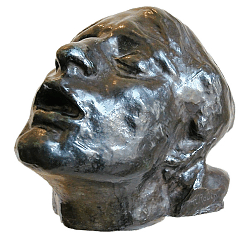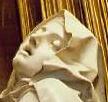Rodin Works: fugit amor, Head of SoRrow, The Last Sigh |
|
As shown on photos made by Jesse Lipscomb, 'Fugit Amor' or 'Fugitive Love' replaced 'The Kiss' as the dominant group at the left door of 'The Gates of Hell' around 1887. 'The Kiss' lived on as an independent work and became known as one as the most famous sculptures of all time. In the same year 1887, 'Fugit Amor' was for the first time exhibited, at
the Sixth International Exhibtion of Painting and Sculpture at the Gallery
Georges Petit. Isolated from its placement on the door, Francesca's
body is facing earth, Paolo has complete legs. The strenuous pose of the woman, lying flat on her belly
and rising aloft with her head and arms, her torso arched back while her
male partner upholds this tension by gripping her necks and bossom,
reminds of Canova's 'Cupid and Psyche' of 1796 (marble, Hermitage). In the
case of 'Fugit amor', Paolo has a great deal of trouble in his supine position clinging to his
lover, rudely pinching her breast. Athena Spear dates the origin of this love couple back to
1883-85,
because its design no longer is dominated by Michelangelo's style, still
clearly influencing earlier elements of 'The Gates' like 'Adam'
and 'Eve' (around 1881); The male figure, turned vertically again, also became known as an isolated character: 'The Prodigal Son'. Paolo's head is used several times in
'The Gates of Hell' – e.g. in 'Paolo and Francesca' and in 'Ugolino and his
Sons' - and known under the title 'Head of Sorrow' as an isolated fragment. Michelle
Facos interpreted the repetetive use of the same face in 'The Gates' as
the introduction of unifying elements to harmonize the chaotic scene of
sinners.
But possibly, these multiplications solely resulted from Rodin's tendency
to treat the shapes he created as mere modules, that could be viewed from
different perspectives, combined with o In 1904, a marble version was carved for Louise Haniel, initially to be named 'Head of Medusa', then 'Head of Orpheus' (reffering to the still singing head of Apollo's son after being torn in bits by the Furies), finally 'The last Sigh'. In 1907, another marble version was ordered by Carl Jacobsen. In 1913, apparently recurred this a marble version to design a 'Monument to Joan of Arc', which was never realised. Like with many Rodin works, this exquisite marble carving was used to produce a mould for bronze casting.
|
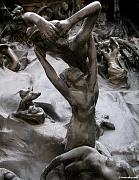
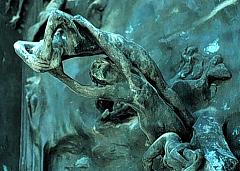 'Fugitive love' is a version of the popular theme of
the lovers Francesca da Rimini and Paolo Malatesta, carried by a whirlwind
in the Second Circle of Hell, where they report their fate to the poet
Dante: at the moment of their first kiss, they were murdered for their illicit love affair
by Francesca's husband and eternally damned. While working at his
monumental 'Gates of Hell', Rodin frequently recurred to this subject and
presented the couple in various constellations, like the famous
'Fugitive love' is a version of the popular theme of
the lovers Francesca da Rimini and Paolo Malatesta, carried by a whirlwind
in the Second Circle of Hell, where they report their fate to the poet
Dante: at the moment of their first kiss, they were murdered for their illicit love affair
by Francesca's husband and eternally damned. While working at his
monumental 'Gates of Hell', Rodin frequently recurred to this subject and
presented the couple in various constellations, like the famous 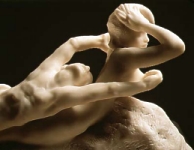 It
is probable that Rodin originally designed the group in this horizontal
position and that the upright direction we see in 'The Gates' developed
only through its attachment to the door.
It
is probable that Rodin originally designed the group in this horizontal
position and that the upright direction we see in 'The Gates' developed
only through its attachment to the door.
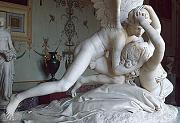
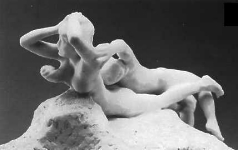 its expression of
desperate desire might have its roots in the passionate relationship between
Rodin and Camille Claudel, unfolding quite rapidly after their first
meeting in Boucher's sculpture class in 1883.
its expression of
desperate desire might have its roots in the passionate relationship between
Rodin and Camille Claudel, unfolding quite rapidly after their first
meeting in Boucher's sculpture class in 1883.
